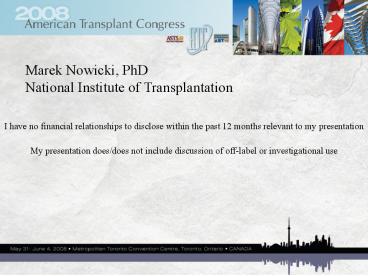RISK ASSESSMENT OF TRANSPLANTING RENAL ALLOGRAFTS - PowerPoint PPT Presentation
1 / 16
Title:
RISK ASSESSMENT OF TRANSPLANTING RENAL ALLOGRAFTS
Description:
My presentation does/does not include discussion of off-label or investigational ... Donor 2 31 years old Latina with history of travel to the endemic area ... – PowerPoint PPT presentation
Number of Views:206
Avg rating:3.0/5.0
Title: RISK ASSESSMENT OF TRANSPLANTING RENAL ALLOGRAFTS
1
Marek Nowicki, PhDNational Institute of
Transplantation
I have no financial relationships to disclose
within the past 12 months relevant to my
presentation My presentation does/does not
include discussion of off-label or
investigational use
2
Testing for antibodies and evaluating the risk
factors for exposure to T. cruzi among organ
donors in S. California single site experience
- Marek Nowicki1, Claudia Chinchilla1, Tom Mone2,
Dem Brucal1, Maria Stadtler2, and Robert Mendez1 - 1National Institute of Transplantation, Los
Angeles, CA and 2OneLegacy, Los Angeles, CA
3
What is Chagas Disease?
- A chronic parasitic infection cause by the
flagellate protozoa Trypanosoma cruzi. - T. cruzi is carried by insects of the Reduviidae
family (aka barbeiros, chupão, vinchucas or
chupança) and also transmitted through blood
transfusions, organ transplants, and
congenitally. - T. cruzi world-wide
- Endemic to most of South and Central America
1618 million cases - 25 of the inhabitants of Latin America at risk
- 25 to 30 infected will progress to irreversible
cardiac, and esophageal/colonic pathology,
causing considerable morbidity and mortality.
4
Background
- March, 2002 - a case of three solid-organ
transplant recipients received the parasite from
the donor - February, 2006 - 2 cases of acute Chagas disease
in heart transplant recipients (Los Angeles, CA) - CDC estimates
- 25,000 - 100,000 Latinos in the US infected with
T. cruzi - 360,000 South and Central Americans immigrate to
the US annually
5
Background (2)
- July, 2006 Ortho Clinical Diagnostic introduced
in Europe a new diagnostic test for Chagas
disease - February, 2007- Ortho Diagnostic EIA is licensed
in the US - April, 2007 National Institute of
Transplantation Laboratory began testing all
OneLegacy donors
6
Initial evaluation (2004)
- 404 donors tested using the Hemagen EIA assay,
the only FDA approved test for the diagnostics of
Chagas disease in the US at that time - 6 initially reactive, 4 repeatedly reactive
- 3 send out for confirmatory testing (CDC)
- 1 (0.25) RIPA confirmed
7
Aim
- To evaluate the prevalence of donors with
risk factors for exposure to vectors carrying T.
cruzi using a questionnaire asking donors
families for self-reported past contacts with
endemic areas
8
Material and Methods
- We used a modified questionnaire originally
developed by Galel et al. (Transfusion, vol. 36,
No. 3, 1996) - Our questionnaire included 5 questions assessing
the risk of the prospective organ donors
exposure to vectors potentially carrying parasite
and/or diagnosed with Chagas disease
9
Questionnaire
- Question 1 Donor diagnosed with Chagas
disease in the past? - Question 2 Donor traveled to the country
where T. cruzi is endemic? - Question 3 Donor spent 6 months in the
country where T. cruzi is endemic? - Question 4 Donor stayed in rural area?
- Question 5 Donor stayed in housing type
preferred by the vector?
10
Material and Methods
- We applied this tool to 491 cases of organ donors
(donor families approached 09/06 and 11/07) - Donors were from S. California area (Kern, San
Bernardino, Santa Barbara, Los Angeles, Ventura,
Orange, and Riverside counties)
11
Material and Methods contd
- We tested all 491 donors using Ortho Diagnostic
EIA detecting antibodies to T. cruzi - Since Chagas testing implementation we tested a
total of 512 donors
12
Results self-reported risk
- 1 questionable self-reported Chagas case (EIA-,
CNR) - 43 were Latinos
- 49 donors were reported to have traveled to
areas where T. cruzi is endemic - 20 donors were reported by their families to
have stayed in the endemic area for more than 6
months - 15.5 stayed in rural areas
- 11.4 donors was reported by the family to have
lived for an extended time in housing potentially
infested by the vectors of Chagas disease
13
Results (2) EIA serology
- 3 donors (0.6) tested positive for antibodies to
T. cruzi by EIA - 1 donor was reported as indeterminate when
tested by the confirmatory assay (IFA RIPA) and
his status is unclear
14
Results (3) EIA reactive donors characteristics
- Donor 1 47 years old Latino born in Guatemala,
extended stay in Mexico - Donor 2 31 years old Latina with history of
travel to the endemic area - Donor 3 56 years old Latino with history of
travel and extended stay in the endemic area
Indeterminate by RIPA
15
Conclusions
- The estimated risk of exposure to the vectors
carrying T. cruzi is higher than previously
reported - Our finding underscores the need to monitor this
new and emerging infection risk among Southern
California organ donors. - Our findings suggest that self-reported risk
assessment tools will results in an unacceptable
rate of deferred donors. - In areas where there is a high number of
immigrants from T. cruzi endemic countries,
screening for anti-T. cruzi donor antibodies
(EIA) is beneficial and recommended.
16
Acknowledgments
- We expresses our thanks to donors families, for
giving the gift of life, the gift of knowledge,
and their help in making this project to happen. - OneLegacy OPO
- Department for Family Services (FCCs, Jeff
Fleming) - Education Department (Stephanie Collazo, Jim
Trisch) - Research Project Management in OneLegacy
- Administrative and Executive Assistance
- Administration (Tom Mone, Renee Hawthorne)
- National Institute of Transplantation
- Laboratorians and NIT staff































